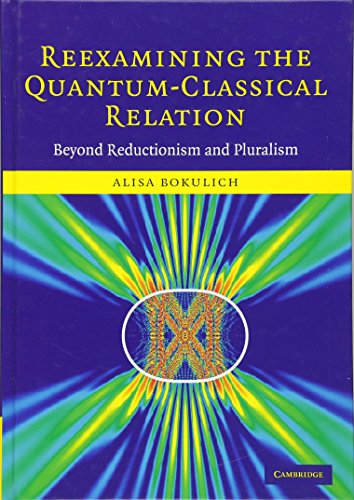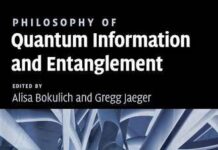
Ebook Info
- Published: 2008
- Number of pages: 208 pages
- Format: PDF
- File Size: 2.00 MB
- Authors: Alisa Bokulich
Description
Classical mechanics and quantum mechanics are two of the most successful scientific theories ever discovered, and yet how they can describe the same world is far from clear: one theory is deterministic, the other indeterministic; one theory describes a world in which chaos is pervasive, the other a world in which chaos is absent. Focusing on the exciting field of ‘quantum chaos’, this book reveals that there is a subtle and complex relation between classical and quantum mechanics. It challenges the received view that classical and quantum mechanics are incommensurable, and revives another, largely forgotten tradition due to Niels Bohr and Paul Dirac. By artfully weaving together considerations from the history of science, philosophy of science, and contemporary physics, this book offers a new way of thinking about intertheory relations and scientific explanation. It will be of particular interest to historians and philosophers of science, philosophically-inclined physicists, and interested non-specialists.
User’s Reviews
Editorial Reviews: Review “Bokulich fully appreciates many subtleties that practising physicists occasionally understand intuitively, but are rarely explicit about. Her ideas are refreshing and original and presented with clarity and erudition. I unreservedly recommend her book to anyone wanting to understand the intricate connections between the classical and quantum worlds.” Sir Michael Berry”… this is a courageous book. More importantly, it is also a very interesting one, and my personal opinion is that Bokulich is typically right whenever she is controversial. This opinion is fed not only by the frequent strength of her arguments, but also by my impression that, as far as 20th century philosophers – as opposed to scientists like Einstein and Bohr – have set its agenda, the philosophy of science has become separated from the actual science it is supposed to describe by a wide gap. Consequently, scientists rarely take notice of its introverted debates … Bokulich’s book obviously attempts to bridge this gap. And successfully so, I would say.” N. P. Landsman”Alisa Bokulich dwells extensively on the history of quantum mechanics and the philosophical ideas of its founding fathers and also on recent developments in physics. The book has thus become a goldmine of information and original ideas about quantum mechanics and its philosophy.” Dennis Dieks”The case study is a novel one and the arguments are strong and tight.” Dean Rickles, Mathematical Reviews Book Description The relation between quantum mechanics and classical mechanics, argued from historical, philosophical, and scientific perspectives. About the Author Alisa Bokulich is a professor in the Philosophy Department at Boston University. Her research focuses on the history and philosophy of physics, as well as broader issues in the philosophy of science. Read more
Reviews from Amazon users which were colected at the time this book was published on the website:
⭐At the start of this important book, Alisa Bokulich (a professor in the history of physics) makes some very interesting points about how some of the ‘quantum giants’ viewed the ongoing debate in atomic physics between realism and instrumentalism (or phenomenology: the modern orthodoxy in physics where mathematics is viewed as a sufficient explanation of physical reality). After challenging the widespread assumption that Heisenberg was a naive positivist or instrumentalist, Heisenberg’s own philosophy of physics is critically reviewed, as his position is often also misunderstood. Bokulich makes the case that Heisenberg explicitly rejected positivism and endorsed a version of scientific realism. She documents how Heisenberg believed that both classical mechanics (CM) and quantum mechanics (QM) were BOTH realistic descriptions of nature “in their own domains” based on his metaphysical view that “nature itself is divided into various regions of reality”. She claims that throughout his writings, Heisenberg was quite critical of phenomenological theories since “… they do not give any real information about the physical content of the phenomenon, about those things that really happen.” “Phenomenological theories are understood as just calculating tools, theories that ‘save the phenomena’ while failing to give us any true insight into nature.” This ties back to the original programme of Natural Philosophy that was begun by Newton (acknowledged by Heisenberg). This was also strongly adhered to by most other earlier famous ‘scientists’ such as Clerk-Maxwell and gradually lost through the 20th Century as American ‘pragmatism’ took over physics. Interestingly, Heisenberg viewed the Ptolemaic system as a phenomenological theory (as I do) and contrasted this with the realistic Copernican / Newtonian theory. I would also point out that theoretical physics has failed to make progress whenever phenomenology is in the ascendant – as a theoretical physicist I can only hope that today this mistaken, metaphysical view is now reaching its zenith.Bokulich’s third chapter focuses on Dirac (in my view, the greatest theoretical physicist of the 20th Century) ‘but, like Heisenberg, one around whom many false myths have accumulated. The first point to know (for those who have yet to read ‘any biographies of Dirac – Helge Kragh’s is the best), is that he started out as an Electrical Engineer and this gave him an appreciation for the ‘power of approximation and one who (unlike Heisenberg) saw “physics as a ‘discipline much closer to engineering than as a set of consistent axiomatic systems”. Unlike his friend Heisenberg, Dirac viewed “even the most well-established parts of quantum theory as open to revision; indeed he takes no part of physics to be a permanent ‘achievement.” Again, unlike Heisenberg and the rival German / Danish approach, Dirac saw QM as “simply the generalization of CM to a non-commutative algebra” based on the ANALOGY with the Hamiltonian theory of CM. He did write, however, in 1945 that “the development of ‘the analogy has been greatly hampered by the mathematical methods available for working with non-commuting quantities” (was this a dig at the Schrödinger approach?).The older Dirac got, the more he turned back to CM for inspiration as he became more dissatisfied with the QED he had help create. ‘Dirac was not one of those who think that agreement in the 14th digit is a definitive validation of the renormalization programme, like when he wrote: “Just because the results happen to be in agreement with observation does not prove that one’s theory is correct.” In true Lucasian tradition he believed that any “branch of ‘physics formulated without equations of motion will remain disconnected from the rest of physics”. Like Dirac, who ‘almost always thought in particle terms, I find it hard to think of developing any such equation for a “wave” that extends over all of ‘space when all particles (especially electrons) are always found highly localized in space.Bokulich makes the focus of this chapter the demolition of the popular myths that Dirac was not interested in the ‘interpretation of QM or that he sided with Bohr (and the Copenhagen school) in the battle with Einstein over QM. The key evidence she uncovers is an unpublished (and almost unknown) manuscript that Dirac wrote at the end of his life favoring Einstein’s deterministic views. Like Einstein, at the end of his life, Dirac also felt isolated from ‘the mainstream and the pressure to conform to the consensus views in physics. It is obvious that these pressures to conform are even greater today, as some of my fellow (retired) physicists are prepared to admit.Professor Bokulich’s fourth chapter begins with a deliciously ironic quote from Hamlet: “Something is rotten in the state of Denmark”. ‘This is a suitable opening for a study of her demythogizing of the ‘standard ‘Copenhagen’ interpretation of QM, associated with Niels Bohr and his allies. She shows how Bohr over-reacted to several failed ‘attempts in the early 1920s to extend Bohr’s original theory (“Old ‘QM”) to the helium atom, where the infamous 3-body problem once again reared its ugly head, as it has since Newton failed with this simple planetary problem. ‘Illogically, the German school seized on this failure to propose that therefore electrons could not possibly ‘follow classical orbits (although this failure didn’t stop the Moon in its tracks!).Rather than viewing the new QM as a revolutionary stage in the development of physics (quantum leap?), Bohr is shown to have viewed this as another continuous step from ‘old QM’. Indeed, she shows how Bohr viewed his “Correspondence Principle” (CP) as really a selection rule – one that even applied to SMALL quantum numbers. Bohr saw the CP as the “deep link between CM, the old QM and the new QM, ‘tying all these theories together”.Bohr’s insistence on using the “concepts of classical mechanics” (like ‘position etc) in QM arose from this evolutionary viewpoint so that ‘”the application of these concepts alone makes it possible to relate ‘the symbolism of the
⭐This book describes the different points of view concerning the relationship of QM and classical physics held by Heisenberg, Bohr and Dirac. There are many philosophical points on which they profoundly disagreed, related to how one should interpret classical physics in a world they all agreed is quantum. Extended quotations support her interpretation of their perspectives.She provides a much more detailed and technical explanation of what Bohr meant by the the correspondence principle than I’ve seen elsewhere.Another interesting point: Dirac’s attitude toward physical theory seems much more light-hearted than I had thought: He doesn’t seem to expect that much of any one theory. Possibly this attitude granted him the freedom to play with the possibilities in bizarre ways, leading to his unbelievable advances in theoretical physics, some of which are hard to imagine anyone else creating.This book also discusses recent advances in semi-classical physics. Despite her attempt to claim that this changes the philosophical relationship between quantum and classical physics, it still seems to me that it’s just mathematics applied to QM, without really implying any really significant change to the CM-QM relationship.I think the book will be of most interest to those interested in how the leading proponents thought about QM. It doesn’t cover Einstein or Schroedinger.
⭐The author sets out to show that classical physical ideas have more continuing relevance to understanding quantum mechanics than is popularly believed to be the case. She says it is inaccurate to claim that quantum ideas entirely replace classical ideas in atomic physics, and that the notion that quantum physics merges into classical physics as you move up the size scale from single atoms to larger objects is also not quite adequate.It was recommended in a public lecture by the physicist Sir Michael Berry.The book is really aimed at graduate physicists and professional philosophers so on both counts it is rather above my head. But if you have a serious interest in physics and A level maths, and persevere, it is worth the effort.Not light reading by any standard.
⭐I love this book. Source of inspiration, knowledge and ideas.
Keywords
Free Download Reexamining the Quantum-Classical Relation: Beyond Reductionism and Pluralism in PDF format
Reexamining the Quantum-Classical Relation: Beyond Reductionism and Pluralism PDF Free Download
Download Reexamining the Quantum-Classical Relation: Beyond Reductionism and Pluralism 2008 PDF Free
Reexamining the Quantum-Classical Relation: Beyond Reductionism and Pluralism 2008 PDF Free Download
Download Reexamining the Quantum-Classical Relation: Beyond Reductionism and Pluralism PDF
Free Download Ebook Reexamining the Quantum-Classical Relation: Beyond Reductionism and Pluralism
